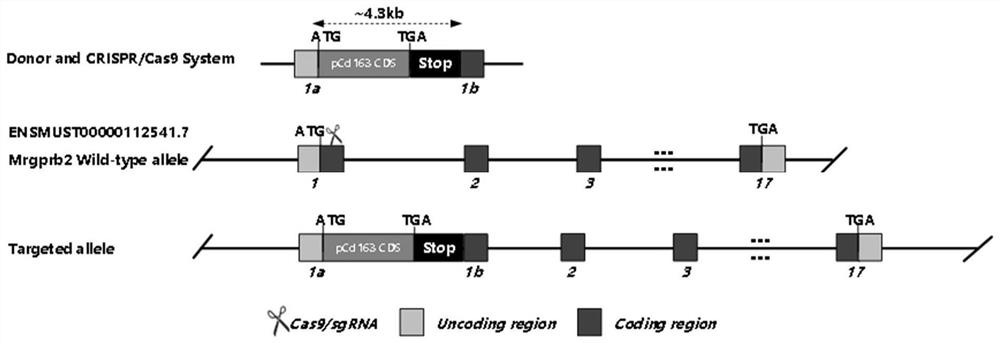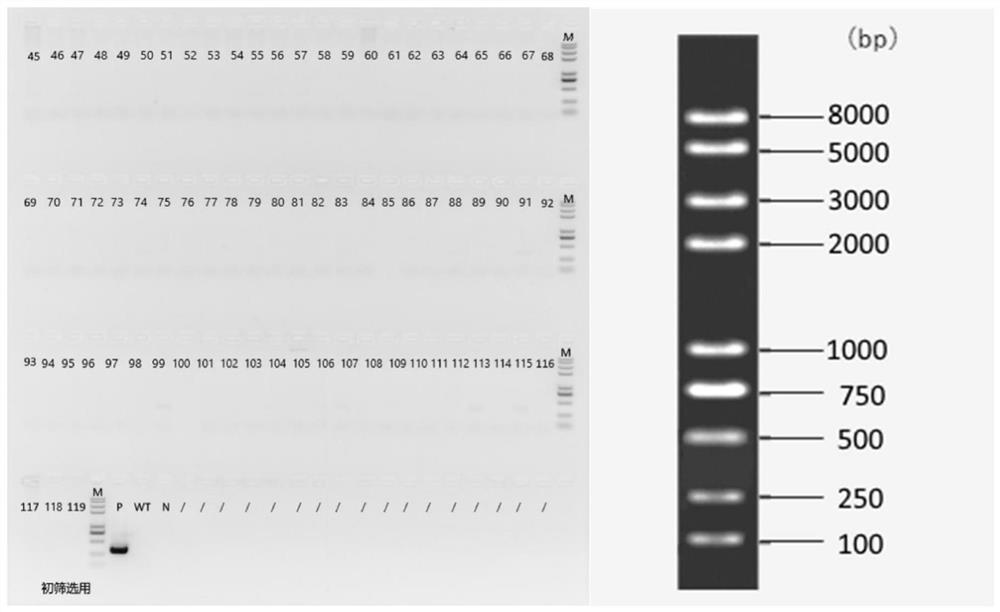Construction method of CD163 gene swine-derived mouse model
A construction method and mouse model technology, applied in the field of genetic engineering, can solve the problems of reduced targeting efficiency, silencing or activation of endogenous genes at non-target sites, complex gene modification requirements, etc., to avoid the effect of drug cross-reaction
- Summary
- Abstract
- Description
- Claims
- Application Information
AI Technical Summary
Problems solved by technology
Method used
Image
Examples
Embodiment 1
[0058] Example 1 Establishment of pCD163 porcine mouse model
[0059] We used homologous recombination and CRISPR / Cas9 technology to replace the porcine CD163 gene with the mouse cd163 gene on the fertilized eggs of B6 background mice, so as to construct a mouse model that can express porcine CD163. For the targeting strategy, see figure 1 .
[0060] 1. Determine the replacement region of the pig-derived fragment and the inserted pig-derived sequence
[0061] According to the structure and function of porcine CD163, we selected the CDS and transcript termination element PolyA of porcine CD163 and inserted it into the translation initiation codon site of mouse Cd163, which terminated the transcription and translation of mouse Cd163 gene at the same time. The selected porcine-derived CD163 gene amino acid sequence is shown in SEQ ID NO: 37, and the strategy diagram is shown in figure 1 shown.
[0062] 2. Vector injection and transplantation to obtain positive mice
[0063] 1...
Embodiment 2
[0095] Example 2 Genotype identification of F1 generation mice
[0096] The 5'- and 3'-end genotypes of CD163 porcine mice were identified, and the mouse tail genomic DNA of the F1 generation mice obtained in step 4) of Example 1 was identified by PCR at both ends after hitting the target using two pairs of primers respectively ( Table 6), the identification scheme and identification primers are the same as in Example 1, and the primers pCD163-KI-5tF2 / pCD163-KI-5tR2 are respectively located outside the 5' end homology arm and in the pig-derived fragment of the targeting vector. The PCR product was amplified, indicating that the target vector was effectively recombined at the 5' end of the mouse genome; 3stop-KI-3tF1 / pCD163-KI-3tR1 were located in the exogenous fragment of the targeting vector and outside the 3' homology arm, as shown in this The primers were amplified to produce PCR products, indicating that the target vector was effectively recombined at the 3' end of the mou...
Embodiment 3
[0097] Example 3 Internal sequence identification of F1 generation mice
[0098] For the No. 58 and No. 59 positive mice identified by PCR at both ends of Example 2, PCR amplification of the internal sequence was further carried out ( Figure 8 and Table 10) and sequencing verification (Table 11), PCR primers were designed for the inserted exogenous sequence, and it was confirmed that the target site homology arm and the genome junction and the knock-in exogenous gene sequences were all correct, and the correct sequenced mice were identified. Positive target mice. Refer to Table 8 and Table 9 for PCR reaction conditions and systems. The sequencing results showed that the inserted CD163 and Stop elements of the 58th mouse (58#) and the 59th mouse (59#) were correct, and the linker sequences of the insertion site and the homology arm were correct, and they were positive mice.
[0099] Table 8 PCR reaction system
[0100] Reagent (Vazyme P112-03) Volume (μl) Spec...
PUM
 Login to View More
Login to View More Abstract
Description
Claims
Application Information
 Login to View More
Login to View More - R&D
- Intellectual Property
- Life Sciences
- Materials
- Tech Scout
- Unparalleled Data Quality
- Higher Quality Content
- 60% Fewer Hallucinations
Browse by: Latest US Patents, China's latest patents, Technical Efficacy Thesaurus, Application Domain, Technology Topic, Popular Technical Reports.
© 2025 PatSnap. All rights reserved.Legal|Privacy policy|Modern Slavery Act Transparency Statement|Sitemap|About US| Contact US: help@patsnap.com



